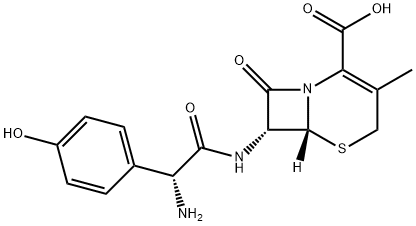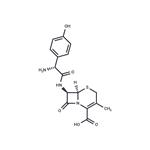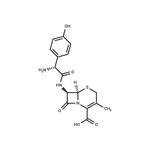Description
Cephadroxil is an orally administered antibiotic, which is very similar
to cephalexin. After oral administration, its peak serum level is slightly
lower than that of cephalexin, but it is excreted more slowly.
Therefore, it can be used for oral administration at 8- or 12-hourly
intervals (Buck and Price, 1977; Pfeffer et al., 1977). Cephadroxil is
still available in a number of European countries (for example, Spain,
Belgium, Luxembourg, Portugal, and Finland, among others).
Chemical Properties
Cefadroxil is a light orange colored powder. It is a cephalosporin antibiotic and is used
for the treatment of bacterial infections. Cefadroxil is stable under recommended storage
conditions. Cefadroxil is not considered hazardous when handled under normal medical
conditions and with good housekeeping
Originator
Oracefal,Bristol,France,1977
Uses
Antibacterial;Bacterial transpeptidase inhibitor
Definition
ChEBI: A cephalosporin bearing methyl and (2R)-2-amino-2-(4-hydroxyphenyl)acetamido groups at positions 3 and 7, respectively, of the cephem skeleton.
Manufacturing Process
1.8 g of sodium N-(1-methoxycarbonyl-1-propen-2-yl)-D(-)-α-amino-(4-
hydroxyphenyl)acetate was suspended in 10 ml of acetone, and one droplet of
N-methylmorpholine was added thereto, and the mixture was cooled to -15°C.There was added 0.85 g of ethyl chlorocarbonate thereto, and the mixture
was reacted at -13°C to -10°C for 30 minutes, and then the reaction solution
was cooled to -20°C.
On the other hand, 1 g of 7-amino-3-methyl-3-cephem-4-carboxylic acid was
suspended in 20 ml of methanol, and 1.4 g of triethylamine was added
thereto to be dissolved, and 0.4 ml of acetic acid was further added thereto.
This solution was cooled to -20°C and the mixed acid anhydride prepared
previously was added thereto. After the mixture was reacted at -20°C for 1
hour, the temperature of the reaction mixture was raised to 0°C over a period
of 1 hour, and the mixture was reacted for 3 hours at the same temperature.
After the reaction, 1 ml of water was added to the reaction mixture, and the
mixture was adjusted to a pH of 1.0 with concentrated hydrochloric acid while
being cooled, and then stirred for 30 minutes, The insoluble matters were
filtered off, and the filtrate was adjusted to a pH of 5.5 with triethylamine.
This solution was concentrated under reduced pressure, and the residue was
diluted with 20 ml of acetone to precipitate white crystals. The crystals were
collected by filtration and washed with ethanol to obtain 1.46 g of white
crystals of 7-[D(-)-α-amino-(4-hydroxyphenyl)acetamido]-3-methyl-3-
cephem-4-carboxylic acid having a decomposition point of 197°C.
Therapeutic Function
Antibacterial
Health Hazard
Exposures to cefadroxil cause certain common side effects. These include nausea, vomiting,
stomach disorders, rashes, itching, unusual tiredness or weakness, yellowing of the skin or
eyes, red, swollen, or blistered skin, unusual bruising or bleeding, sore throat, respiratory
distress, tightness in the chest, swelling of the mouth, face, lips, or tongue, decreased urination, dark urine, vaginal itching, odor, or discharge, fever, chills, joint pain, and seizures.
Prolonged or long-term use of cefadroxil should be avoided.
Precautions
Cefadroxil should be used only under proper medical health care since it has properties
of penicillin allergy, renal function, gastrointestinal tract damage. Pregnant women and
breast-feeding women should avoid exposure to cefadroxil.





